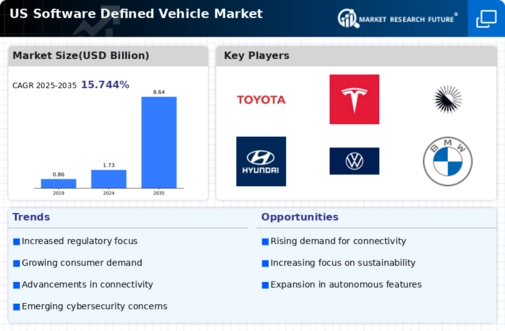The US Software Defined Vehicle Market is experiencing rapid growth and evolution as the automotive landscape adapts to technological advancements and changes in consumer expectations. This market encompasses vehicles equipped with advanced software capabilities that enable features such as over-the-air updates, enhanced connectivity, and improved automation. As the industry shifts towards electric and autonomous vehicles, companies are increasingly focused on integrating software innovations to enhance vehicle performance, user experience, and safety.
The competitive dynamics within this market reflect a diverse range of players, including traditional automakers, tech companies, and specialized software developers, all vying for market share and technological leadership. The race towards a fully integrated software ecosystem is reshaping how vehicles are designed and function, with implications for production strategies, partnerships, and consumer engagement.Aptiv stands out in the US Software Defined Vehicle Market due to its strong emphasis on advanced safety technology and connectivity solutions.
The company leverages its deep expertise in software integration to provide innovative solutions that enhance the driving experience through real-time data analytics and responsive vehicle systems. Aptiv's robust network within the automotive ecosystem enables it to collaborate effectively with various manufacturers and suppliers, demonstrating a strong market presence that is essential for driving forward software-defined innovations.
With capabilities in providing software platforms that facilitate vehicle automation and enable features such as driver assistance systems, Aptiv has established itself as a key player in advancing automotive technologies. Its commitment to safety and performance positions it favorably in the competitive landscape, as more manufacturers integrate software into their vehicle offerings.
In the realm of the US Software Defined Vehicle Market, Toyota is making significant strides through its emphasis on connected vehicle technologies and sustainable mobility solutions. The company is deeply invested in developing integrated software platforms that enhance vehicle connectivity, enabling features such as remote vehicle management and comprehensive infotainment systems. Toyota is leveraging its substantial R&D capabilities to create vehicles that are not only efficient but also equipped with cutting-edge technologies that respond to consumer demands for convenience and safety.
The company's key products include hybrid and electric models that are increasingly incorporating advanced software functionalities, which further solidify its competitive edge.
Strategic mergers and acquisitions have also empowered Toyota to enhance its technological capabilities in the software domain, enabling it to maintain a strong presence in the evolving automotive market in the US. With a focus on innovation and customer-centric solutions, Toyota aims to redefine mobility and address the shifting landscape of consumer preferences in the automotive sector.






















